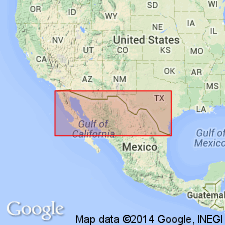
- Usage in publication:
-
- Ojinaga formation
- Modifications:
-
- First used
- Dominant lithology:
-
- Shale
- Limestone
- Sandstone
- Clay
Summary:
Is first used as a name for a thick Lower and Upper Cretaceous formation limited to the area of the Ojinaga basin, State of Chihuahua, MX. Name was arbitrarily assigned to the youngest sedimentary bedrock unit in the basin; stratotype not designated. Overlies Lower Cretaceous Aurora formation (new). Basal beds are thin-bedded gray limestone, which pass into shale about 700 ft thick; overlying prominent ridge-forming massive sandstone about 100 ft thick contains fossil wood and plant fragments; uppermost 1,000 ft is alternating clay and thin sandstone beds -clay at two horizons contain large fossil bones, thin sandstone 250 ft above the massive sandstone contains abundant Turritella-like small shells, about 400 ft higher is 20 ft thick clay with numerous limestone nodules that locally have abundant Exogyra shells, 50 ft higher is another clay bed with numerous ammonites and nautili; minor coal is present in beds less than 1 ft thick. Total formation thickness at least 2,000 ft. Probably includes Washita division of Lower Cretaceous as well as Upper Cretaceous beds; Lower Cretaceous-Upper Cretaceous unconformity was not observed.
Source: GNU records (USGS DDS-6; Denver GNULEX).

- Usage in publication:
-
- Ojinaga Formation*
- Modifications:
-
- Biostratigraphic dating
Summary:
Is formation at Cannonball Hill east of Cienequilla, Chihuahua, MX. Identification of the ammonite SPATHITES RIOENSIS from this locality dates part of the unit as middle Turonian (Late Cretaceous). Index species also noted to occur in upper part of Rio Salado Tongue of Mancos Shale and basal part of overlying Atarque Sandstone Member of Tres Hermanos Formation in central NM.
Source: GNU records (USGS DDS-6; Denver GNULEX).

- Usage in publication:
-
- Ojinaga Formation*
- Modifications:
-
- Biostratigraphic dating
- AAPG geologic province:
-
- Permian basin
Summary:
Ammonite collections from a 0.23-m-thick bed of friable, sooty weathering, petroliferous limestone in Ojinaga Formation 9.2 m (30 ft) above top of Buda Limestone are assigned to lower Cenomanian ACOMPSOCERAS INCONSTANS zone. Collection from USGS Mesozoic locality D10757, east side of Mule Canyon in southern Quitman Mountains, 0.85 km (2,800 ft) N 65 degrees W of Love Triangulation Station, Eagle Mountains SW 7 1/2 min quad, Hudspeth Co, TX in Permian basin. Collections are from Powell's (1963) bed A. The A. INCONSTANS zone is correlated with the upper lower Cenomanian MANTELLICERAS DIXONI zone of northwest Europe. Age of lower part of unit is early Cenomanian (Late Cretaceous).
Source: GNU records (USGS DDS-6; Denver GNULEX).
For more information, please contact Nancy Stamm, Geologic Names Committee Secretary.
Asterisk (*) indicates published by U.S. Geological Survey authors.
"No current usage" (†) implies that a name has been abandoned or has fallen into disuse. Former usage and, if known, replacement name given in parentheses ( ).
Slash (/) indicates name conflicts with nomenclatural guidelines (CSN, 1933; ACSN, 1961, 1970; NACSN, 1983, 2005, 2021). May be explained within brackets ([ ]).

